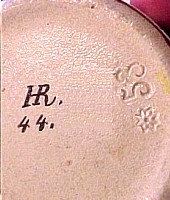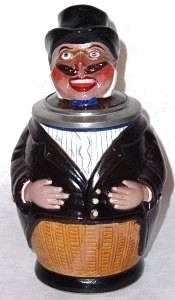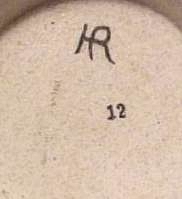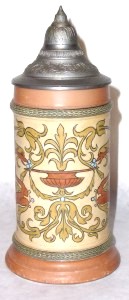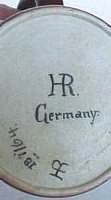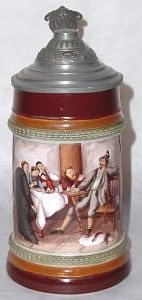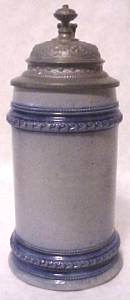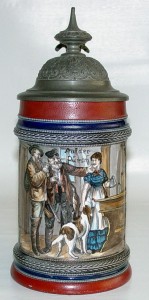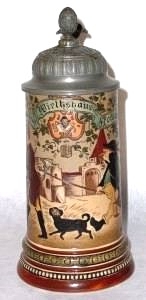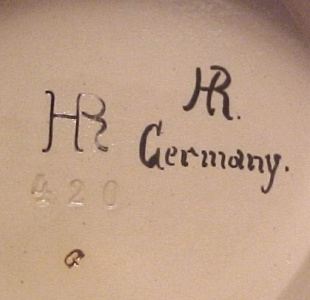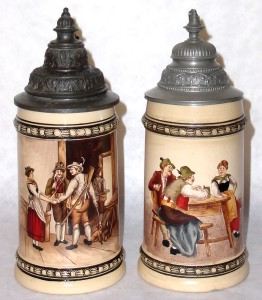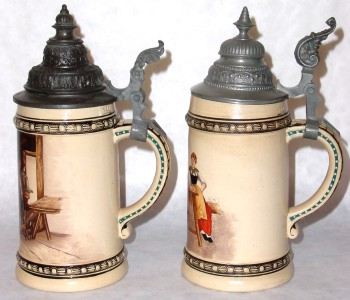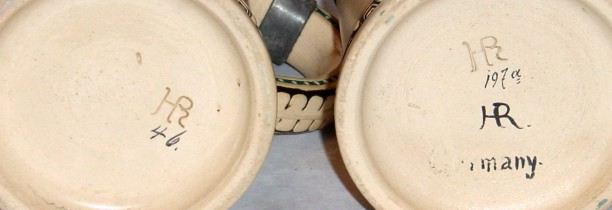|
(DECORATING MARK, NOT A FACTORY LOGO)
On most HR porcelain steins made after 1887 there are two HR marks. In Mike's 1980 book he concludes they are both mark #2 (bottom row, left). I quote, "Mark #2 (see Figure B) is found exclusively on porcelain steins. It appears to be tooled into the base with a sharp stylus-type tool and then inked over in black. Because each mark was done by hand, the mark is erratic and never came out exactly the same on any two steins. It is not uncommon to find the mark appearing twice on the same stein base." In fact, the mark NEVER appears twice on the same stein, because the marks are two different marks, only one of which in inked over a tooled (inscribed) mark. The "type 1c/2" logo appears exclusively on porcelain steins just as Mike indicated, but the "type 5" mark appears on HR marked steins in all three materials, stoneware, ivory stoneware and porcelain, as well as any stein, by any manufacturer, overpainted by HR. Type 5 - hand inked: This is the Mike Wald "other Mark #2" (bottom row right). It is inked on and is usually followed by a period. When the stein is also marked "Germany" both the HR and Germany are followed by a period. From the early 1880s, this mark was used on all steins decorated in Freising OVER PREVIOUSLY APPLIED DECOR, whether they were manufactured there or not. The term "previously applied decor" does not include clear glazes, it applies only to colored glazes. ~~~~~~~ TYPE 5 MARK, WHY SOME, AND NOT OTHERS?
The "type 5" mark is probably the least understood mark used by HR. You will find I have spent the most time with this mark, often repeating myself in the hope of making its use understood. Above, we have three hand painted, HR marked steins, they are each marked differently and all are products of the Freising factory. In order to determine why they are marked the way they are we have to determine how they are alike and how they differ. The stein on the left is a saltglaze character stein that has been painted in full color over the cobalt and manganese underglaze. In addition to its original marks, it is marked with an inked on "type 5" HR mark. The porcelain stein in the middle has been decorated entirely with underglaze paints and left in the bisque. This stein was not marked with the "type 5" mark and carries only the "type 1c/2" logo. The porcelain stein on the right was painted in underglaze colors of brown and cream. The piece then had a painting, done in china paints, applied over the cream underglaze. It carries both the "type 1c/2" logo and inked on "type 5" HR mark. The stein on the left, and the stein on the right, have had colored decor applied over the original colored underglaze, and are both marked with the inked on "type 5" HR mark. The stein in the middle has a bisque finish with the paint applied directly to the unglazed body, and therefore does not have the inked on "type 5" HR mark. It could have been given a clear glaze and still not have the "type 5" mark. Remember, clear glazes over, or under the decor do not count. So, the "type 5" mark is applied only when a colored glaze is applied over another colored glaze. Let us look at some additional examples. ~~~~~~~ WITHOUT THE TYPE 5 MARK
Hauber & Reuther produced examples of blue and grey saltglaze steins painted in full color, like the model 187/19 on the right. This stein carries only the "type 1a," incised factory logo. When the steins were initially fired only the decorative bands and the grooves above and below them were colored with cobalt. The rest of the stein was left in the grey like the one on the left. After the piece was fired and saltglazed, the body, rim, and base could still be painted without applying the "type 5" mark because there were no colored underglazes used on those areas. ~~~~~~~
Model 420 -Why would an etched Merkelbach & Wick produced stein with a "type 3" logo also have a "type 5" mark? The fact that this mark is on the stein means that after it was originally decorated some part of the stein was repainted. Steins marked this way are rare; so far only two have been reported, this one, and a #411. ~~~~~~~
Model 46 and 197a - Here is another excellent, and final, example of the way the "type 5" mark is used. While both of these steins are ivory stoneware blanks produced by Merkelbach & Wick, and each is decorated with a hand painted scene by Hauber & Reuther, they are marked differently. Both steins are the Merkelbach & Wick, type "I" body style, and both are marked with the incised, "type 3" HR logo. The stein on the left has only an inked on decor/model number "46," while the stein on the right has the inked on decor/model number "197a", as well as the HR "type 5" decorator mark and the word "Germany." The stein on the right has had white highlights added, over the glaze, to the woman's blouse and to the shirt and sock of the man in the center. Also the coat he is sitting on has been added over the glaze. Because these highlights and the coat were added over previously applied color, the "type 5" mark was added to the stein. |






